12+ SAMPLE Nurses Meeting Minutes
-
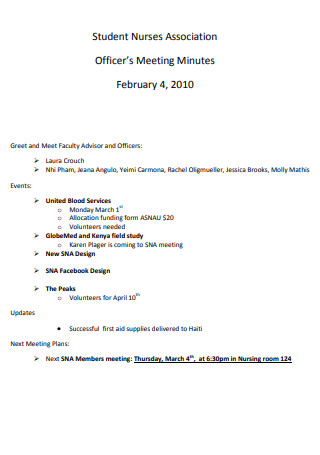
Student Nurses Association Officers Meeting Minute
download now -
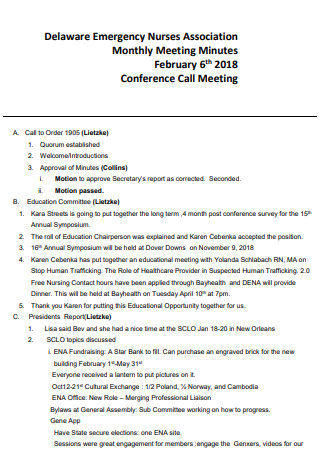
Emergency Nurses Association Monthly Meeting Minutes
download now -
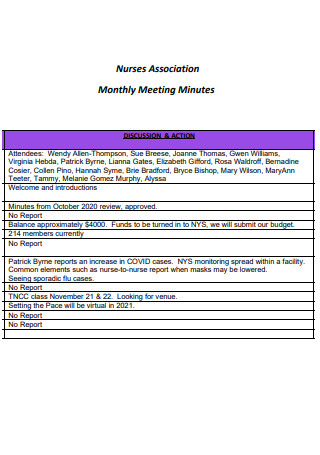
Nurses Association Monthly Meeting Minutes
download now -
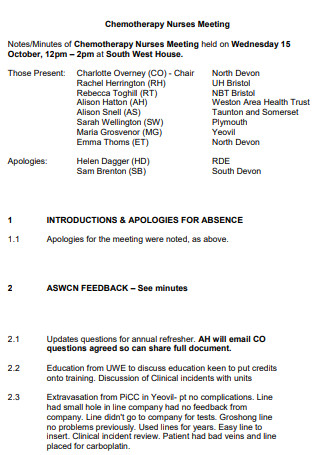
Chemotherapy Nurses Meeting Minutes
download now -
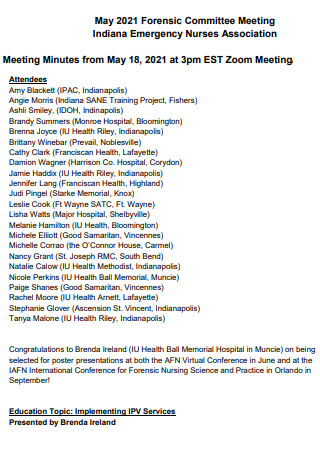
Forensic Nurses Meeting Minutes
download now -
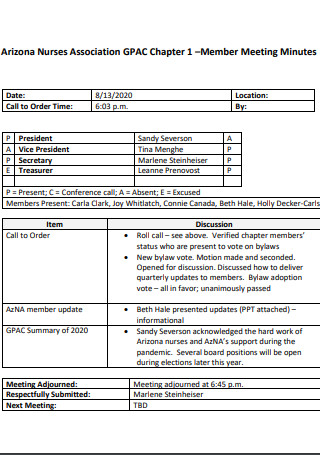
Nurses Association Member Meeting Minutes
download now -

Young Cancer Nurses Meeting Minutes
download now -
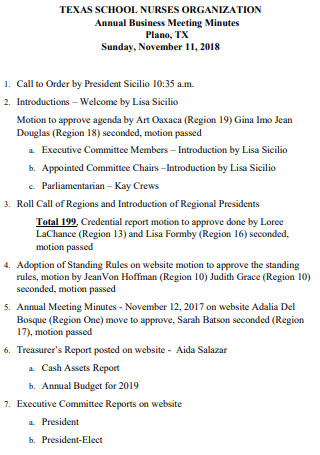
Nurses Annual Business Meeting Minutes
download now -
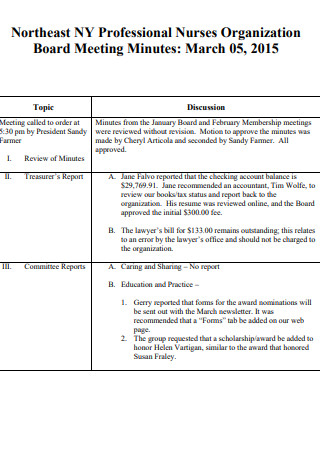
Professional Nurses Organization Board Meeting Minutes
download now -
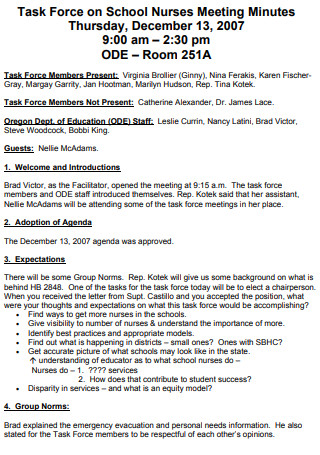
School Nurses Meeting Minutes
download now -
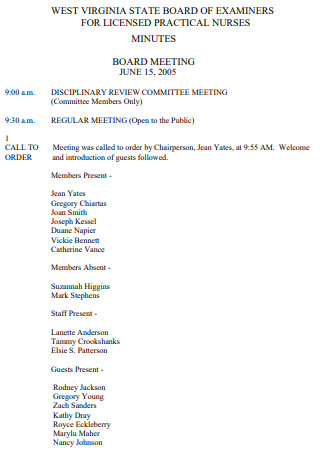
Practical Nurses Meeting Minutes
download now -

International Organization Nurses Meeting Minutes
download now -
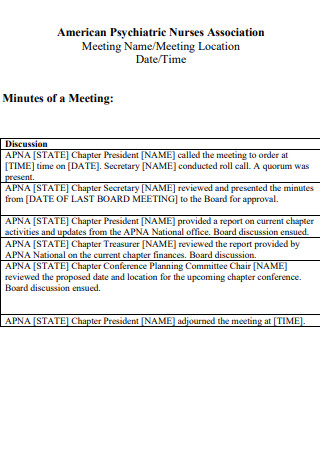
Psychiatric Nurses Association Meeting Minutes
download now
FREE Nurses Meeting Minutes s to Download
12+ SAMPLE Nurses Meeting Minutes
What Is Nurses Meeting Minutes?
What Is the Importance of Accurate Minutes?
What Are the Ethical and Legal Considerations for Meeting Minutes?
Elements of the Meeting Minutes
How to Write Meeting Minutes
FAQs
What Are the Minutes of a Meeting For?
Why Is it Important to Document Nursing Meeting Minutes?
When to Request Confidentiality of Nursing Meeting Minutes?
A dreary business meeting can drag on indefinitely if it is not productive. If you’re in charge of organizing a meeting, you may make it less painful by starting the meeting in a good — and possibly even enjoyable — manner. Maintain order while keeping the atmosphere light. In some cases, you may discover that starting a meeting on a positive note allows you to accomplish significantly more work.
What Is Nurses Meeting Minutes?
Meeting Minutes are a written record of the events of a meeting held by a firm, an organization, or a group of people that are kept on file for future reference. It is sometimes referred to as the meeting minutes. Minutes of a meeting are written records of what took place during the meeting. Aside from that, it retains a record of the decisions that were reached during the conversation. Furthermore, the employee will have the opportunity to revisit the crucial subject that was mentioned during the conference. The objective of meeting minutes, in the end, is to meticulously record information from meetings such as attendance, discussion, who is responsible for which task, how to handle problems, and so on, as well as the vision and mission. Because of this, taking minutes of meetings and making precise notes throughout each formal meeting discussion is an essential aspect of every formal meeting discussion. There are other nurses meeting minutes templates that are associated with the original one. We have nursing advisory committee meeting minutes, board of nursing meeting minutes, nursing commission regular meeting minutes, nursing practice meeting minutes, nursing committee meeting minutes, nursing assistants meeting minutes, nursing practice council meeting minutes, nursing education committee meeting minutes, nursing directors meeting minutes, business meeting minutes, and nursing section board meeting minutes. These templates can be downloaded anywhere in any search engine.
What Is the Importance of Accurate Minutes?
Minutes of meetings serve four key functions: they serve as communication tools, legal papers, instruments for excellent management practices, and historical records. They should be well documented. Keeping meeting minutes is a vital part of disseminating critical information, such as decisions made by the clinical research or evidence-based practice committee in preparation for the facility’s application for accreditation. A meeting’s minutes can be used to verify compliance with policies, rules, regulations, and other requirements during a legal deposition or trial. Meeting minutes are admissible as evidence in court. For example, the minutes of an infection control committee at a facility could be subpoenaed by attorneys in the course of a bedbug infestation litigation. Meeting minutes are used by managers, supervisors, and administrators to help identify who is going to do what and when, and they provide an excellent opportunity for follow-up on concerns and problems that have arisen. Minutes serve as a tool for management in making decisions about future meetings and necessary agenda items. minutes are also useful tools for project management, as they help to move projects along by providing well-written updates on progress and commitments. Members’ accountability and responsibility for the committee’s work and purpose are made easier as a result of these publicly stated pledges.
Meeting minutes serve as historical records, assisting new and present participants in recalling what has and has not been accomplished in the past. They also assist committee chairs and administrators in evaluating the committee’s accomplishments and shortcomings, among other things. After doing a thorough study and synthesis of meeting minutes, the administrator may determine that it is more cost-effective and time-efficient to unite two ill committees into a single powerful group in order to maximize efficiency.
What Are the Ethical and Legal Considerations for Meeting Minutes?
The structure of meeting minutes is determined by unit and institutional policies and standards of practice, but they should adhere to established policies and standards of practice. Their electronic storage allows them to be easily searched for information by themes, headings, dates, phrases, and keywords. Accessibility is critical during accreditation and Magnet recognition surveys. The distribution of copies of reports from ad hoc committees well in advance of the meeting is recommended if the meeting will contain potential action or votes based on reports, such as those from committees on special projects. Also, consider attaching them as attachments to your minutes so that they are easily accessible. Studying the information provided before the meeting will assist you in organizing and writing your minutes.
Meeting events must be accurately and objectively reported and preserved since they have a vital historical and legal function, and in some cases, they can even be used as legal papers. Keep in mind that collecting meeting minutes entails more than just taking notes during the meeting. When it comes to reconciling confidentiality requirements with accreditation or other regulatory requirements, you should check with your facility’s attorney. It may be necessary to restrict access to meeting minutes when sensitive topics such as performance improvement or peer evaluation are discussed in the minutes. It is critical to have only one “minutes” file and only one person who is in charge of keeping this file in order to ensure accuracy and anonymity. Because of the need of maintaining confidentiality, legally sound policies must be created and implemented on who writes and controls the minutes of meetings, as well as who has access to them and who will receive copies of the following each meeting. Additionally, predetermined and agreed-upon ground rules for secrecy, meeting participation, meeting timing, and members’ expected conduct are required. Members, for example, are required to arrive on time and to remain for the duration of the meeting, among other things. Everyone must respect and listen to their fellow members, as well as adhere to time constraints and effective meeting agendas. Finally, all policies and procedures pertaining to meetings should be reviewed and updated on a regular basis.
Elements of the Meeting Minutes
The minutes of the meeting contains information on upcoming meetings, including precise times and dates, as well as the names of those who filed and approved the minutes. Having to prepare for a new meeting is a frightening set of instructions for the group members. Minutes of Meetings must contain some specific components in order to be more meaningful. It is often referred to as the characteristics of meeting minutes.
How to Write Meeting Minutes
Everyone on the team is working 12-hour days, you had to turn in your own patient accountability reports yesterday, and you had plans for a night out with your best friends on Friday. In order to ensure that everyone gets what they need – and in record time – how do you conduct the necessary staff meeting? The same tactics may be used to host an effective and successful meeting whether you’re working under a time constraint with a stressed-out staff or scheduling your nurses’ staff meeting during a period of typical downtime.
1. Prepare an Agenda
Plan ahead of time and make a copy of the agenda available to everyone who will be in attendance. Allow the nurses a day or two to read and examine your list so that they can make ideas prior to the meeting if any adjustments or additions are required. When everyone is aware of what is about to happen, the likelihood of serious complications arising at the last minute is reduced.
2. Start the Meeting on Time
Start the meeting on schedule and limit the amount of time you provide for each issue to be discussed in detail. Set an end time for the meeting and keep track of the time as you progress through the meeting to ensure that you are staying on schedule. This is crucial when you have patients who are waiting for treatment and treatments that need to be delivered.
3. Take Control of the Meeting
Take command of the meeting from the very beginning. Introduce the meeting with a remark that firmly implies the meeting’s focus and objectives. With your aggressive opening statement, you should be able to clearly establish the tone and tempo for the rest of the meeting — else everyone should be too terrified to stir the pot.
4. Few Extra Minutes
Allow a few extra minutes in the meeting for unexpected items and excessively lengthy conversations that could derail the meeting’s schedule, but set a time restriction on those discussions as well to prevent them from running overtime.
5. Use the Meetings
Nurses should use the meetings as a forum to discuss issues that are relevant to their profession. The nursing profession is a difficult one, and you will find that your team is a lot more helpful during meetings when they have a place on the agenda to express problems and seek good solutions.
The minutes of meetings serve as a record of the work completed by groups or committees. Not only does timely and correct documentation reflect the past and present status, but it also assists in establishing a course for future events.
FAQs
What Are the Minutes of a Meeting For?
Meeting minutes are the notes that are taken during a meeting to document what took place! In contrast to a meeting agenda, it serves as a record of the choices made and activities requested by the committee. Despite the team’s best efforts, they are not a minute-by-minute record, but rather a compilation of the most important details that the team will want to know.
Why Is it Important to Document Nursing Meeting Minutes?
Nurses in all practice settings benefit from being able to capture meeting minutes in a professional and accurate manner. Continue reading if you want to improve your ability to produce reliable marketing meeting minutes.
When to Request Confidentiality of Nursing Meeting Minutes?
When it comes to reconciling confidentiality requirements with accreditation or other regulatory requirements, you should check with your facility’s attorney. It may be necessary to restrict access to meeting minutes when sensitive topics such as performance improvement or peer evaluation are discussed in the minutes.
Minutes of Meeting are documents that record the exact date, time, venue, and activities of a meeting. It is a type of official evidence that provides information about your whereabouts. Additionally, it provides clear documentation of who attended the meeting and who did not attend, as well as who did not attend. In addition, it elaborates on the agenda and conversation topics, as well as on who will be held accountable and how to solve the problem or achieve the desired results. Generally speaking, group discussions do not require a long period of concentration. Aside from that, members have a tendency to get sidetracked. As a result, minutes assist in keeping the conversation from becoming sidetracked and in keeping the conversation on the topic.
